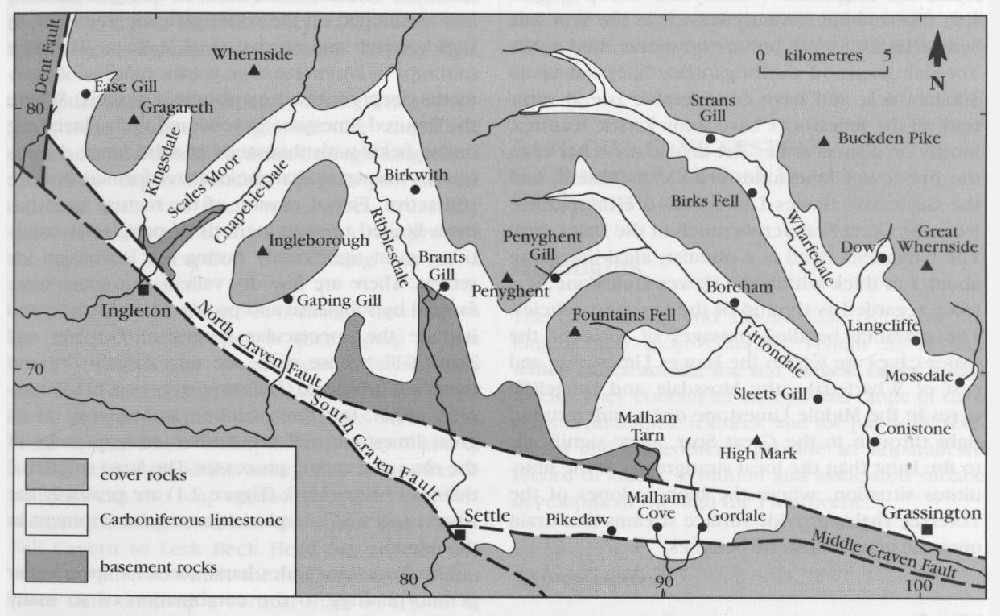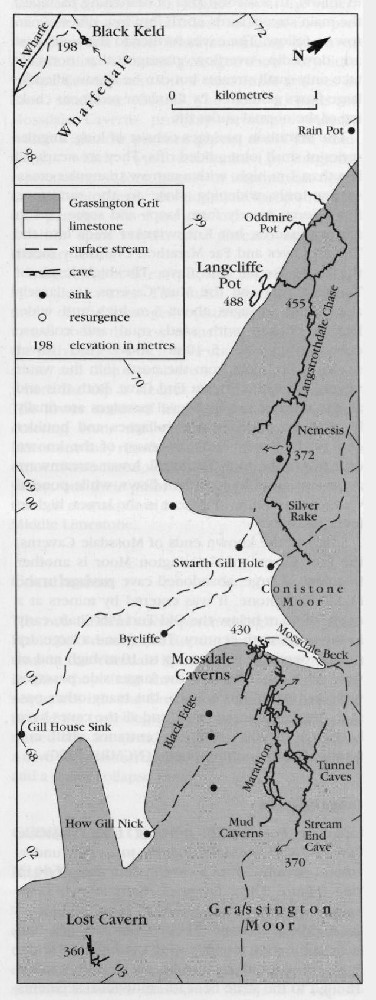Black Keld catchment area
Highlights
Mossdale Caverns and Langcliffe Pot are the two most extensive cave systems developed in the Yoredale limestones. The known cave passages in Langcliffe Pot breach the sandstones and shales into a lower Yoredale limestone, and both caves drain through relatively impermeable beds into the underlying Great Scar Limestone.
Introduction
The two long cave systems lie beneath the southern slopes of the Conistone and Grassington Moors, east of Wharfedale; between them they drain a large part of the slopes of Great Whernside
Many of the cave passages were originally described by Leakey (1947), Grandison (1965) and Monico (1989a). Further descriptions of the caves are given by Brook et al. (1988), and the hydrology and geomorphology of the area have been discussed by Brook (1971a, 1974b).
Description
Mossdale Caverns
Mossdale Caverns are entered where Mossdale Beck flows into the largest sink in the area. Over 10.5 km of cave passages have been mapped
The Marathon passages consist of long, angular series of small joint guided rifts. They are nearly all less than 1 m high, with a narrow triangular cross-section only widening close to the sandstone floor. Some merely form loops and some end in narrow fissures, but Kneewrecker leads into the Tunnel Caves and Far Marathon eventually meets the larger Stream End Cave. The high levels of Tunnel Caves and the Mud Caverns are largely abandoned passages about 5 m high and wide, heavily choked with sand, mud and collapse debris; they lie 5–10 m above the lower streamways. Inlets from the north join the water which flows into Stream End Cave. Both this and all the ends of the high-level passages are finally blocked by impenetrable collapses and boulder chokes. In flood conditions most of the known cave fills to the roof. The small, lower streamways are swept clean by turbulent flows, while ponded water deposits fine sediment in the larger, higher-level passages.
South of the known ends of Mossdale Caverns, the Lost Cavern of Grassington Moor is another fragment of large, abandoned cave passage in the
Langcliffe Pot
Langcliffe Pot is very different from Mossdale Caverns, with five sinks draining to a single underground streamway, in a cave system over 9600 m long
The stream then enters a vast zone of blockfall and collapse, estimated to have total dimensions of 100 m by 50 m and 40 m high. Beyond, the stream flows in the Hardraw Limestone but enters a perched phreas, preventing further exploration, before the Great Scar Limestone is entered. A large abandoned inlet passage enters from the south-east before the sump; this extends eastwards as a series of tall rifts along the Silver Rake mineral vein, eventually terminating in a choke.
Dye tests of the Swarth Gill sinks into the
Interpretation
The underground drainage system which feeds Black Keld is one of the largest and deepest in Britain, though only a small proportion of its cave passages are accessible at present. It is also unique, in that the cave drainage is constrained initially within the Yoredale limestones but then breaks through into the underlying Great Scar Limestone, and resurges about 160 m lower down from near the base of the carbonate succession. The caves therefore breach the intervening shales and sandstones which are normally hydrological barriers. Two of these aquiclude breaches are visible in Langcliffe Pot. The breakthrough from the
The complex plans of both the Mossdale and Langcliffe caves are unusual for sites in the Yoredale limestones, which more typically have a single stream passage, as typified by Fairy Holes. Mossdale Caverns has the more complex system, partly due to multiple sink points along the Mossdale valley. Its divergent, branching pattern approaches that of phreatic maze caves such as Knock Fell Caverns, and may reflect development under conditions of frequent back-flooding caused by its restricted drainage outlet. Langstrothdale Chase and Marathon Passage are the longest stream passages in the upper limestone beds in the two caves; they are almost entirely developed on joints, but they are constrained to drain downdip to the south-east within the vadose zone, though the resurgence of Black Keld lies to the north-west.
Mossdale Caverns has an older series of large relict passages along its north-eastern sector through Tunnel Passage, Stream End Cave and the High Level Mud Caverns. This may have developed from sinks higher in Mossdale Beck which have been subsequently choked, probably by an input of glacial debris. The large passages below the modern sink in Mossdale Scar may constitute an old phase which has been reinvaded, and these now drain into the small, relatively immature passages on the base of the limestone. There are other abandoned and choked passages within the entrance complex and Western Passages. Abandoned sinks occur further down the valley, but floor deposits of alluvium and peat now prevent Mossdale Beck from continuing down to Bycliffe Sink. The cave passages show very little vadose development other than small grooves in their sandstone floors. The known parts of Mossdale Caverns probably developed initially within a shallow perched phreas above the sandstone, which was unaffected by regional rejuvenation. A long history of intermittent flooding and epiphreatic development has etched the cave passages out of the joint network to produce a rather open version of a phreatic maze cave (Palmer, 1975).
Langcliffe Pot is morphologically simpler than Mossdale Caverns. The initial phreatic development of the passages occurred up to several metres above the base of the limestone. It is only the active inlets which have cut down to the sandstone, and then rise above it further downstream where the dip is steeper than the cave gradient. The lower series of largely abandoned passages entering from the east in the Hardraw Scar Limestone may represent an earlier phase of development associated with old sinks in the Mossdale valley, but their point of origin is unknown and there is now no flow though from the sinks in the
Conclusion
The two influent caves perched high above their Black Keld resurgence are the longest known systems in the Yoredale limestones. They are unique in that they drain through shale and sandstone sequences into the Great Scar Limestone beneath; two of the hydrological breaches which have permitted this are already visible in Langcliffe Pot, as a cave canyon entrenched into the non-carbonates and a major collapse zone.


